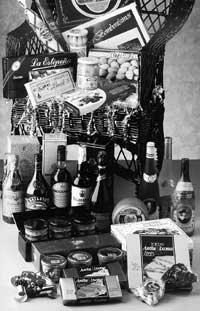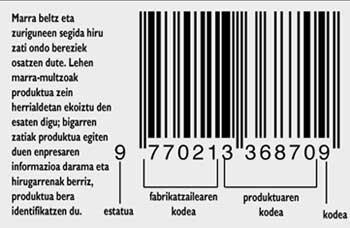Barcode
The EAN (European Article Numbering) barcode, which was unveiled in 1977, began to be used in stores in 1982 and is currently deployed in more than fifty countries.
In supermarkets we see that the products carry a barcode formed by black and white stripes. However, seeing this sequence of stripes, buyers do not know the price of the product. In case of doing so, we should also consult with the head of the supermarket and he will carry out the process that we will now explain to know the price.

The barcode control system is divided into four parts: firstly, as we have just mentioned, we have the sequence of black and white stripes that we can see written in the product itself; secondly, there is a scanner that sends the laser beams to the barcode; thirdly, we have a detector that will collect the rays reflected in the barcode and finally, a computer that classifies and processes the information obtained by the detector.
Many times we have seen the supermarket cashier pass the products one by one on a coffee table. That little table, of course, is not anyone. On the table there is a transparent window that makes the product pass over it. This is where the process that we mentioned above begins. And in supermarkets, under the table that makes us pass all the products purchased, there is a laser scanner type hard disk.
The laser sends infrared rays acting on a silver mirror. Under that transparent window we see there is a spinning disk. The infrared rays that have sounded in the mirror trace this disc and begin to explore the barcode of the product. The rotating disc allows you to read the product barcode from any angle. This makes it easy for the cashier to work as you don't have to find the barcode part of the product and look at the window.
After reading the barcode, these laser beams are reflected. The reflected rays are directed to the detector through the disc and mirror and the rays become electrical signals. The next step is to send to the computer the electrical signal that has become binary code. The computer will then decode the information contained in the binary code and find in its memory the price of the product. This whole process is currently being done with some speed. Once the product has passed on the table, the cashier can read the price on the computer screen.
The general operation of the barcode has therefore been explained, but more specifically, the number of parts of the barcode. It has already been previously commented that laser beams track the barcode, since ultimately the information about the product is on those black and white lines. Thus, black stripes and tips are not arranged in any way; if we realize, black lines have different widths and the tips are narrower and wider in different products. The composition of the stripe sequence determines the information stored in it. The width of the barcode ranges from 0.26 to 0.66 millimeters and can vary depending on the size of the product.

The succession of pale black stripes consists of three distinct parts. The first group of brands tells us the country in which the product has been produced, the second part carries the information of the company that makes it and the third identifies the product. Black lines almost completely absorb light from laser beams, so the amount of light they reflect is very small. The bleached areas, on the contrary, reflect a lot of light and this powerful signal is directed to the detector. The detector therefore receives different amounts of light or signals for each country, producer and different product. Then the computer, knowing these three data, will find in its memory the price of the product.
As we can see, this invention offers the customer a fast and error-free service. Undoubtedly, the new system has also benefited supermarkets. Supermarket staff can get detailed information about the sales and products you have in the warehouse. In addition, when a product is about to run out, the computer will place the order automatically. The computer is also capable of reporting on the demand for each product.
Barcode, although it may seem like the next discovery of vacuum, is a breakthrough for certain services.
Buletina
Bidali zure helbide elektronikoa eta jaso asteroko buletina zure sarrera-ontzian











